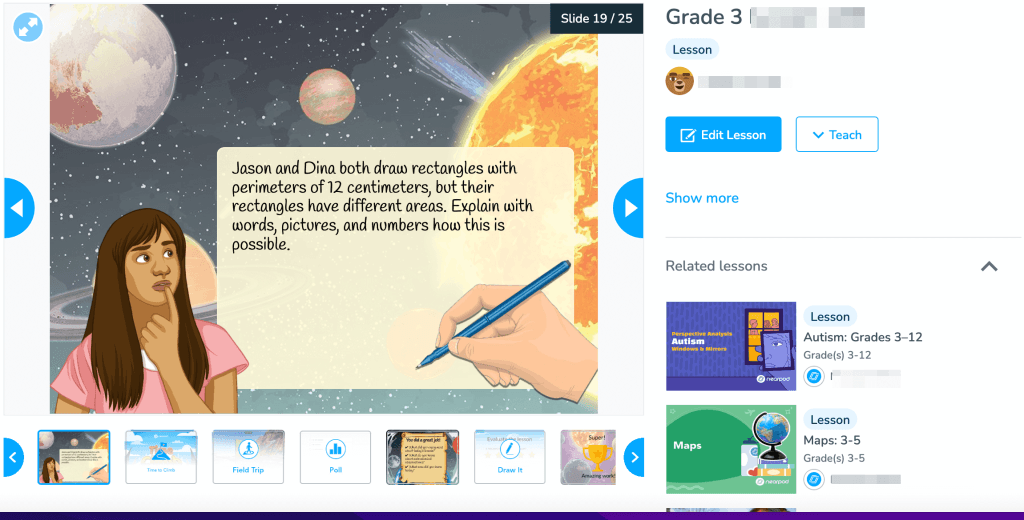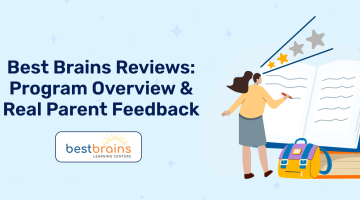12 Best Math Intervention Strategies
reviewed by Jo-ann Caballes
Updated on August 7, 2025
Math is a challenging subject, so even the best students can face some academic difficulties here and there. However, the proper elementary and middle school math intervention can help seal your kid’s potential knowledge gaps, developing a strong math foundation.
Let’s find out how effective interventions are and what strategies you can use to ensure your child’s academic success!
What are math intervention strategies?
According to Dr.Emily Levy, founder of EBL Coaching:
“Math intervention strategies are strategies used to develop a student's core academic skills that they have difficulty with.”
This practice can help students develop a deeper understanding of mathematical principles, improve their problem-solving skills, and boost their confidence in math. By starting intervention strategies for mathematics early, educators can help kids overcome study difficulties and develop a strong math foundation.
What makes a math intervention strategy effective?
- Customized syllabus tailored to student’s needs
- Explicit instructions
- Hands-on manipulatives
- Mnemonics, visual and audial aids
- Positive reinforcement
- Technology integration, including games and online resources
Customized syllabus tailored to student’s needs
All math intervention programs have customized syllabus tailored to students’ needs. Each kid has different strengths and knowledge gaps. Tutors need to identify them to create a tailored curriculum for the kid.
Explicit instructions
Provide explicit instructions and guide a child through the study process. Set clear expectations and break down complex concepts into smaller, more manageable steps. Demonstrate how to solve the problems with step-by-step instructions.
Hands-on manipulatives
Use hands-on manipulatives and real-world examples. That way, your child will understand how math can benefit them in daily situations like shopping. All your study sessions should be fun and interactive.
Mnemonics, visual and audial aids
Mnemonics, visual, and auditory aids are invaluable tools for math intervention because they can enhance students’ memory and recall skills. Don’t be afraid to use memorable phrases, acronyms, music, rhymes, or even memes to make math lessons more “catchy.”
Positive reinforcement
Everyone likes to be complemented, so positive reinforcement is a crucial part of the study process. Encouragements boost student’s confidence, so they are more ready to learn something new and more likely to show a desire to solve more complex tasks.
Technology integration
Technology integration can be a powerful tool in math intervention, ensuring that a child will get more personalized and engaging study sessions. Online resources can provide extra practice while remaining fun and gamified. Currently, there are a myriad of interactive tools that allow students to explore concepts at their own pace.
When to use math intervention strategies
Math intervention strategies should be used with those students who struggle with some math concepts or this subject in general. If your kid is perfect in math and just wants to learn new material earlier than their peers, they can use general tutoring.
Consider intervention strategies for math if your child has knowledge gaps to fill. Here are some indicators that may show you that your kid needs additional assistance:
- Consistent low grades
- Difficulty with specific concepts
- Avoidance of math and test anxiety
- Disruptive behavior during math classes
- Loss of study motivation
- Learning disabilities
It is vital to identify and address these signs early to prevent further academic difficulties and help students develop a positive attitude towards math.
Math Intervention and Special Education
Math intervention strategies are crucial in supporting students with special education needs. During traditional studies, everyone in the class follows the standardized curriculum.
Meanwhile, you can modify intervention best practices to individual student’s needs. If a kid needs special treatment, teachers will provide it to them. They will create a customized curriculum to close knowledge gaps and be comfortable with the child.
Some elementary and middle school math intervention programs may be personal with just a teacher and a student, while some may be held in small groups. It all depends on students’ needs and conditions. There is no one-size-fits-all approach when it comes to the math intervention curriculum.
Stefano Lodola, owner of Think in Italian, supports this idea.
“It has been found that the most successful treatments were small-group ones, especially those led by experts or teachers.”
Scholars and teachers have been providing effective, easy math learning mechanisms through small-group instruction, online courses and programs for Math, and scaffolding techniques in learning Math.
What makes this intervention effective is a closed teaching involvement with the students by allowing them to discover how to best learn and adopt the value of Math.

It’s OK to gather in small groups during offline and online math intervention programs
While looking for a math intervention tutor, ensure they know how to deal with kids similar to yours. If your child has dyscalculia, ask a teacher whether they have experience teaching kids with it. If the student has ADHD or autism, ask a tutor to provide a certification that they can work with neurodiverse students.
Math intervention with Brighterly

We, at Brighterly, offer a personalized tutoring approach that is vital for math intervention. We create a personalized syllabus to close students’ knowledge gaps. This targeted support ensures that students receive the specific help they need to overcome math challenges.
Brighterly’s tutors use interactive teaching methods to create the best math intervention programs. We like to use online interactive tools to make math more engaging and enjoyable.
We offer flexible scheduling options to accommodate the needs of any student. Another benefit of our tutoring sessions is that they are done online, so kids can receive knowledge from everywhere, even from the comfort of their couch.
10 Math intervention strategies
- Diagnostic assessment
- Intermixing challenging and easy problems
- Copy, cover, compare
- Self-monitoring
- Peer-assisted learning strategies
- Use of manipulatives
- Visual aids
- Say, ask, check
- Differentiated instructions
- Scaffolded instructions
- Integrating technology
- Graphic organizers
Diagnostic assessment
A diagnostic assessment is a test that can help you identify a student’s strong and weak points. We recommend you conduct those mini-exams every month. Weekly quizzes may not show progress. Meanwhile, quarterly exams put too much pressure on a kid. So, the month-to-month math assessment is a golden medium.

Morally support your child, showing that the grades are not the most important during those assessments. Explain to them that you won’t allow them to write off this test since you want to see their true knowledge and help them become better at math.
Intermixing challenging and easy problems
Intermixing challenging and easy problems is an effective strategy since it won’t burden the child with overly challenging tasks. This practice improves students’ engagement because they feel confident after successfully solving dozens of easy tasks. This confidence allows them to try some complex math problems.
It also prevents boredom and keeps math students engaged. It’s crucial to balance difficulty when intermixing challenging and easy problems during math intervention. Don’t overwhelm the child with too much of complicated tasks. Switch to another topic only after the student seals their current knowledge gap.
Cover, copy, compare
Cover, Copy, and Compare is a simple but working strategy for improving math fluency. During it, you provide them with a test where you have already written the correct results but have covered them. Later, the student solves the problem and provides their answer. After that, you uncover the correct answers to check whether your child answers them correctly.
If the student answers incorrectly, figure out the knowledge gap that prevents them from understanding this problem. Practice until the child understands the logic behind the task.
This strategy forces the kid to recall the answer from the memory. It provides immediate feedback, as the kid can instantly check their answers.
Self-monitoring
Self-monitoring is a must-have skill for any student. That way, kids learn that “everybody makes mistakes” and that the most important thing in life is to react to potential missteps promptly.
It also benefits them during mathematics intervention strategies. During self-monitoring, they analyze their answers, independently identifying their knowledge gaps.
This skill is crucial for any human, as it can help in any aspect of life.
Here is how your child can control their math knowledge during self-monitoring studies:
- Flashcards
- Sorting cards
- Focusing on weak areas
- Math games and apps
Teach your kids to ask themselves questions like “Do I really understand this question?”, “What strategies can I use to solve this?”, “If this method doesn’t work, what should I try next?”. The most effective interventions improve a child’s self-awareness, which is vital not only for math but for their whole future life.
Peer-Assisted Learning Strategies (PALS)
Peer-Assisted Learning Strategies (PALS) is a cooperative learning approach where one student acts as a tutor, teaching others different math concepts. In each lesson, the student switches roles to ensure that every student is in the group at least once as a “group tutor”.
This approach is based on the principle that the best way to comprehend something is by trying to teach it. The responsibility of potential tutoring forces the kid to understand the idea so they can explain it in simpler terms to their peers. It’s one of the most interesting examples of math intervention that fits small student groups.
Use of manipulatives
Manipulatives transform abstract ideas into real-world experiences. You can use anything to make math palpable. It can even be groceries or stories with kids’ favorite movie heroes. Math interventions and math tutoring strategies use manipulatives to provide a visual representation of complex ideas.
Let’s imagine that you are the parent of a 3rd-grade kid who has problems with understanding the multiplication and division processes. If you ask them to evenly share 45 apples between 9 students, they perform it within minutes. During this process, you can explain the interconnection between multiplication table and division.

Visual aids
Visual ads are another way to make math more tangible. Visual representation allows students to see the connection and relationships between seemingly incoherent concepts.
You can use number lines to represent math operations and relationships between numbers. Venn diagrams help you to compare and contrast different data sets. Flowcharts can be used to show the sequence of steps in a problem-solving process. Each aid has its own meaning.
To ease future math lessons, you can print those visual aids and put them on the wall. Select the ones that suit the task and encourage students to create their own visual aids.
Say, ask, check
Say, Ask, Check is a structured approach to problem-solving for math intervention. It can help students develop their troubleshooting skills and improve their confidence by using three steps:
- Say: The student explains the problem in their own words.
- Ask: The student asks questions about the problem, such as “What do I know?” and “What do I need to find out?”
- Check: The student checks their work to ensure their answer is reasonable and accurate.
This practice is called one of the best math intervention programs since it encourages students to think about the problem and understand what is being asked. It can help students build confidence in their math abilities, as they get immediate feedback where the teacher supports them even if they use not-so-perfect wording.
Differentiated instructions
Differentiated instruction is a teaching approach where tutors create multiple learning paths to ensure that the student can switch between them and learn the topic. It’s a practice for small groups (2-5 students), but it can also be done even during individual tutoring sessions.
Before the first lesson, tutors determine students’ knowledge gaps and the preferable type of content delivery (visual, auditory, kinesthetic). During the lessons, the tutor provides students with a choice between multiple possible activities, and kids can choose how they will learn today. Students can learn by creating their own game, completing the worksheet, singing a song, writing a story, etc.
Scaffolded instructions
Scaffolded instruction is a teaching approach where the tutor gradually reduces their support, allowing students to take over their learning process. It involves breaking down complex tasks into small and manageable steps. As students become more independent, tutors begin to withdraw the support, just like parents who teach their kids to ride a bike.
Break the problem and visualize how to solve it. Provide prompts and cues, so students won’t get lost without your help. Gradually withdraw support while still providing feedback. Scaffolded instruction approach teaching kids to become more independent. This skill benefits them during adulthood.
Integrating technology
Technology integration can become a powerful tool for math intervention, providing students with personalized support within arm’s reach. Special tools easily identify knowledge gaps and offer videos and assessments to help them improve in math.

The most well-known self-study technology solutions are DreamBox, Prodigy, ST Match, Mathletics, and Duolingo’s math course. Meanwhile, Brighterly tutoring service also has multiple online games that supplement the session, combining human and tech experiences into one study session.
Graphic organizers
Graphic organizers are visual representations that can help students visualize relationships, patterns, and connections between different mathematical ideas. The most common types of graphic organizers used in math are Venn diagrams to compare and contrast data sets, and pizza charts to show the part of the whole.
You can also try to use flowcharts to show the sequence of steps in a troubleshooting process. If you need to show relationships between ideas, use mind maps.
Graphic organizers provide visual anchors, which help students recall information. They also structure information, helping students to boost their problem-solving skills.
Conclusion
These 10 math intervention strategies can help your child become their best at math. Provide individual approach with explicit instructions. Make math tangible by using manipulatives and visual aids. Modern kids are technology natives, so it’s better to implement some online service or game into your study sessions.
Ready to unlock your child’s math potential? Book a free first lesson with Brighterly’s expert tutors!
We offer personalized online tutoring with a variety of virtual tools, games, and manipulatives to show our students the logic behind math. We regularly perform math assessments to ensure that a child understands math, not just memorizing rules.

















